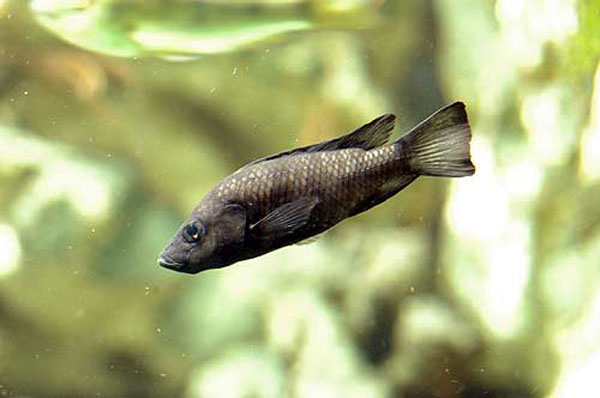| Cichlidae (Cichlids), subfamily: Pseudocrenilabrinae |
| 9.1 cm SL (male/unsexed) |
|
demersal; freshwater |
| Africa: endemic to Lake Barombi Mbo, Cameroon (Ref. 52307, 81260). |
|
Dorsal spines (total): 13-15; Dorsal soft rays (total): 10-11; Anal spines: 3-3; Anal soft rays: 8-9. Diagnosis: relatively robust, body depth 30.0-37.0% of standard length; mouth large; upper jaw 28.5-35.2% of head length; lateral line system on head markedly enlarged and inflated; series of dark blotches along the sides often visible; microbranchiospines usually absent on outer faces of second through fourth gill arches (Ref. 81260).
Description: snout 31.0-36.6% HL; preorbital depth 17.8-24.5% HL; mouth relatively large, upper jaw 28.5-35.2% HL; outer teeth in oral jaws with 2 unequal cusps or minor cusp reduced to a shoulder or absent; inner row teeth tricuspid at all sizes; lower pharyngeal jaw slightly longer than wide, teeth small and hooked; gill rakers small, conical; microbranchiospines usually absent; lateral line system on head markedly enlarged and inflated (Ref. 81260).
Coloration: many individuals completely black in coloration, also with black fins (Ref. 52307, 81260). Black coloration sometimes restricted to dorsum and blending into a number of uneven blotches on lower flanks and fins; some individuals grey with a series of dark grey or black blotches along mid-line with a second series above mid-line; both black and grey individuals often with a characteristic crimson iridescence on opercle; "tilapia spot" present in soft dorsal fin of juveniles but is lost with age (Ref. 81260). |
| Predatory; reported to kleptoparasitize the freshwater crab Potamon africanus (Ref. 81260). Mainly feeds on shrimp and insect larvae; ovophilic, maternal mouthbrooder; in aquarium, males have been observed moutbrooding albeit rarely (Ref. 52307) |
|
Critically Endangered (CR); Date assessed: 16 February 2009 (B1ab(iii)+2ab(iii)) Ref. (130435)
|
| harmless |
Source and more info: www.fishbase.org. For personal, classroom, and other internal use only. Not for publication.
